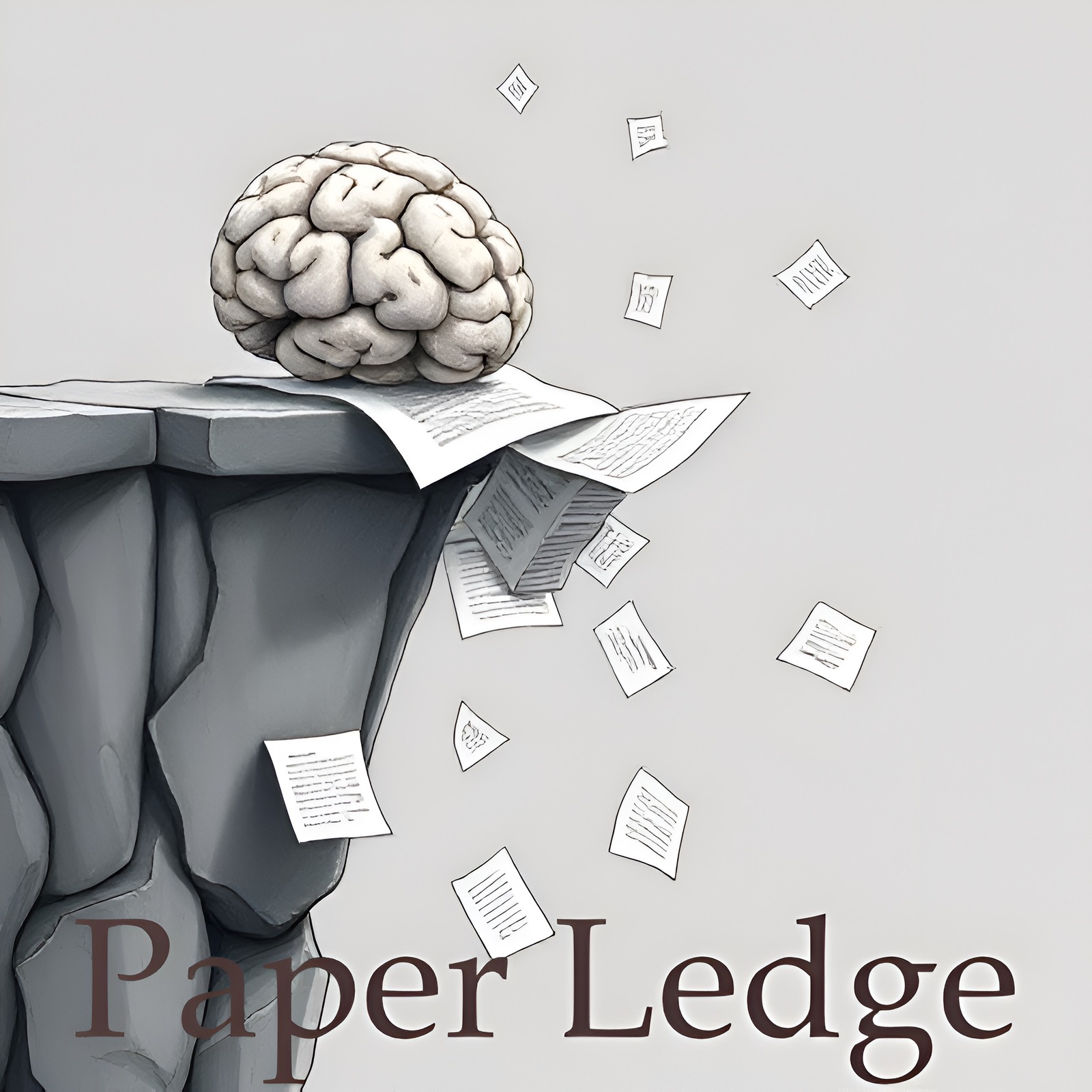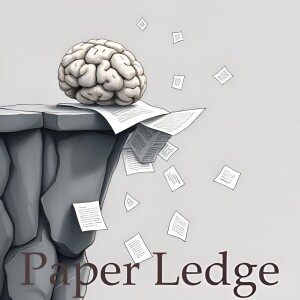PaperLedge

PaperLedge where research meets storytelling is a revolutionary podcast where cutting-edge research meets AI-powered storytelling. Hosted by the Ernis, whose blend of gentle reassurance, cosmic wonder, explanatory clarity, and enthusiastic charm makes complex research accessible to everyone. Each episode, Ernis transforms the latest academic papers into engaging, jargon-free audio experiences that deliver key insights in digestible formats. Whether you’re a researcher seeking interdisciplinary perspectives, a student supplementing your studies, or simply curious about scientific breakthroughs, PaperLedge has something for you.
Episodes
Episodes



Saturday Nov 01, 2025
Software Engineering - Stitch Step-by-step LLM Guided Tutoring for Scratch
Saturday Nov 01, 2025
Saturday Nov 01, 2025
Hey PaperLedge crew, Ernis here, ready to dive into some fascinating research that's going to change the way we think about learning to code! Today, we're tackling a paper about helping newbie programmers, specifically those using visual, block-based languages like Scratch, squash those pesky bugs.
Now, if you've ever dabbled in Scratch, you know it's designed to be super user-friendly. Instead of typing out lines of code, you drag and drop these colorful blocks to build your programs. This really cuts down on syntax errors – those annoying typos that can bring your whole project crashing down. But even with blocks, you can still make mistakes, what we call semantic bugs.
Think of it like building with LEGOs. You might have all the right pieces, but if you put them together in the wrong order, your spaceship might end up looking like a wonky duck! These semantic bugs are about the logic of your program, and they can be really tricky for beginners to figure out.
So, what's the traditional approach to helping these budding coders? Well, usually, it's showing them the correct code – the "answer key," if you will. But this paper argues that just showing the answer, while it fixes the problem, doesn't really teach you how to solve problems. It's like giving someone a fish instead of teaching them how to fish, right?
"Simply presenting the correct program is pedagogically ineffective."
That's where Stitch comes in! Stitch is this super cool interactive tutoring system. Instead of just handing over the solution, Stitch guides you through the debugging process, step-by-step. It's like having a coding coach who doesn't just tell you what's wrong, but helps you understand why it's wrong.
Here's how it works:
Stitch's "Diff-Analyze" module compares your buggy code to a correct version.
It pinpoints the most important differences – those crucial blocks that are causing the problem.
Then, using a powerful language model (basically, a sophisticated AI), it explains why those differences matter in plain English.
You get to inspect these highlighted blocks, read the explanations, and then selectively apply fixes.
It's an iterative process, meaning you go through these steps again and again until your program finally works as intended. Think of it as peeling an onion, layer by layer, until you get to the core of the problem.
The researchers put Stitch to the test, comparing it to other methods of automated feedback. And guess what? Stitch came out on top! The study showed that this step-by-step, guided approach is much more effective at helping learners understand and fix their bugs than simply showing them the answer or using standard automated feedback tools.
This is huge for anyone involved in programming education – teachers, curriculum designers, even the creators of these block-based languages. It suggests that we need to rethink how we provide feedback and focus on building problem-solving skills, not just fixing errors.
So, here are a couple of things that really got me thinking:
If "showing the answer" is so ineffective, why is it still such a common practice in education, not just in programming?
Could the principles behind Stitch be applied to other learning domains, like math or writing, where understanding the "why" is just as important as getting the right answer?
What does "effective feedback" really look like in a world increasingly driven by technology?
That's the scoop on Stitch! A fantastic piece of research that highlights the importance of guided, iterative learning in programming. It makes you wonder about the best way to help people learn. Until next time, keep those learning gears turning!Credit to Paper authors: Yuan Si, Kyle Qi, Daming Li, Hanyuan Shi, Jialu Zhang



Saturday Nov 01, 2025
Saturday Nov 01, 2025
Hey PaperLedge learning crew, Ernis here, ready to dive into some seriously cool tech shaping our future: self-driving cars! Today, we're looking at a paper that's like a super-organized cheat sheet for how these cars "see" the world. It's all about object detection – how they figure out what's around them, from pedestrians to traffic lights.
Think of it like this: You're driving, and your brain is constantly processing information from your eyes, maybe even your ears (hearing that siren!). Self-driving cars need to do the same, but they use a whole bunch of sensors:
Cameras, like our eyes, to see the world.
Ultrasonic sensors, similar to how bats navigate, using sound waves to detect nearby objects.
LiDAR, which shoots out lasers to create a 3D map of the surroundings.
Radar, like what ships use, to detect objects even in bad weather.
The paper looks at how these sensors work, their strengths and weaknesses, and how they can all be combined – like a super-powered sense of awareness for the car.
Now, here's where it gets really interesting. The paper isn't just rehashing old news. It's focusing on the cutting edge – things like Vision-Language Models (VLMs) and Large Language Models (LLMs). Think of LLMs and VLMs as giving the car a “brain” that can not only see an object but also understand what it is and what it might do.
Imagine the car seeing a person standing near the curb. An old system might just identify it as "pedestrian." But with VLMs and LLMs, the car can understand: "pedestrian near curb, facing street, likely to cross." That extra context is crucial for safe driving!
"By synthesizing these perspectives, our survey delivers a clear roadmap of current capabilities, open challenges, and future opportunities."
The paper also talks about the massive amounts of data needed to train these systems. It's not just about having a bunch of pictures; it's about organizing and understanding that data. They categorize different types of data, including:
Ego-vehicle datasets: What the car sees from its own perspective.
Infrastructure-based datasets: Information from sensors built into the roads and cities.
Cooperative datasets: Cars talking to each other, or to the infrastructure – like a fleet of vehicles sharing information about traffic and hazards. V2V, V2I and V2X
This data sharing is like a group of friends all spotting different details and sharing to make sure everyone is safe.
Finally, the paper dives into the different algorithms used for object detection, especially those powered by something called Transformers. These are like advanced filters that help the car focus on the most important information and make better decisions.
So, why does all this matter?
For the everyday listener: Safer roads! Better traffic flow! Imagine a world with fewer accidents and less time stuck in traffic.
For the tech enthusiast: This is the bleeding edge of AI and robotics. It's a fascinating look at how we're building machines that can perceive and interact with the world around them.
For the future driver (or non-driver!): Understanding these technologies helps us prepare for a world where self-driving cars are commonplace.
This paper gives us a roadmap of where we are, where we're going, and what challenges we still need to overcome.
Here are a couple of thought-provoking questions that come to mind:
If self-driving cars are using all these advanced sensors and AI, could they eventually be better drivers than humans? And what are the ethical implications of that?
How do we ensure that the data used to train these systems is fair and unbiased, so that self-driving cars don't perpetuate existing societal biases?
Alright learning crew, that's the paper for today. I hope you found it as insightful as I did. Until next time, keep learning!Credit to Paper authors: Sayed Pedram Haeri Boroujeni, Niloufar Mehrabi, Hazim Alzorgan, Ahmad Sarlak, Mahlagha Fazeli, Abolfazl Razi



Saturday Nov 01, 2025
Saturday Nov 01, 2025
Alright learning crew, Ernis here, ready to dive into some seriously cool AI stuff with you. Today, we're talking about research pushing the boundaries of what AI can do, moving us towards what they're calling an "agentic organization." Think of it like this: instead of one super-smart AI trying to solve everything, we're talking about a team of AI agents, each with specialized skills, working together like a well-oiled machine.
The big idea is that by working collaboratively and simultaneously, these AI agents can tackle problems that would be way too complex for a single AI to handle. It's like how a construction crew can build a skyscraper faster than one person could, even if that person was a super-genius builder.
Now, to make this AI dream team a reality, the researchers behind this paper have come up with a new way for large language models – you know, the brains behind things like ChatGPT – to think. They're calling it "Asynchronous Thinking," or AsyncThink for short. Sounds fancy, right? But the concept is actually pretty intuitive.
Imagine you're planning a big event, like a wedding. Instead of trying to do everything yourself, you break it down into smaller tasks: booking the venue, choosing the menu, sending out invitations, etc. Then, you delegate those tasks to different people. That's essentially what AsyncThink does.
Here's how it works:
First, there's an "organizer" AI. This AI is like the project manager. It takes a complex problem and breaks it down into smaller, more manageable "sub-queries."
Then, the organizer assigns these sub-queries to different "worker" AIs. These workers are like specialists, each focusing on their assigned task.
As the workers come up with solutions, the organizer collects and merges their knowledge, like assembling puzzle pieces.
Finally, the organizer puts everything together to produce a coherent solution to the original problem.
The really clever part is that the way the organizer structures this thinking process can be optimized using reinforcement learning. Think of it like teaching the organizer how to be a better project manager, so it can delegate tasks more effectively and get results faster.
"AsyncThink achieves 28% lower inference latency compared to parallel thinking while improving accuracy on mathematical reasoning."
So, what does this all mean in practice? Well, the researchers found that AsyncThink was not only faster than traditional parallel thinking (where all the AI agents work on the same problem at the same time), but it was also more accurate, especially when it came to mathematical reasoning. It's like saying that delegating tasks and having specialists focus on them not only gets the job done quicker, but also results in fewer mistakes.
But here's the kicker: AsyncThink can also generalize its learned skills. That means it can apply its asynchronous thinking capabilities to new and unseen tasks without needing additional training. It's like learning how to manage one type of project and then being able to apply those same skills to manage a completely different type of project.
So, why should you care about this research? Well, if you're an AI researcher or developer, this could be a game-changer for building more powerful and efficient AI systems. If you're a business owner, this could lead to AI-powered solutions that can solve complex problems faster and more accurately, giving you a competitive edge. And if you're just a curious learner, like me, it's fascinating to see how AI is evolving and becoming more like a collaborative human team.
Here are a couple of questions that popped into my head while reading this:
How far can we push this "agentic organization" model? Could we eventually have AI systems that can self-organize and solve problems without any human intervention?
What are the ethical implications of having AI systems that can think and collaborate in this way? How do we ensure that these systems are used for good and not for harmful purposes?
I'm excited to hear your thoughts on this, learning crew. Let me know what you think in the comments!Credit to Paper authors: Zewen Chi, Li Dong, Qingxiu Dong, Yaru Hao, Xun Wu, Shaohan Huang, Furu Wei



Saturday Nov 01, 2025
Saturday Nov 01, 2025
Hey PaperLedge crew, Ernis here, ready to dive into some seriously cool research! Today we're talking about how AI is helping to keep the wheels turning – literally – in steel factories. Imagine a massive steel rolling mill, where giant pieces of hot metal are being shaped into everything from car parts to construction beams. It's a high-stakes, high-temperature environment, and even a small breakdown can cost a fortune.
This paper explores a smart system designed to predict when things are about to go wrong, before they actually do. Think of it like having a super-attentive doctor constantly monitoring a patient's vital signs, but instead of a human body, it's a giant, complex machine.
So, how does it work? Well, the researchers installed industrial-grade cameras all over the factory floor, constantly watching everything from the alignment of equipment to the movement of the red-hot steel bars. These cameras are like the eyes of the system, feeding live video streams to a central "brain," which is a powerful computer running some sophisticated deep learning models. Deep learning models, in this context, are algorithms that can learn to recognize patterns and anomalies in the video footage.
Instead of relying solely on traditional sensors, which can sometimes miss subtle changes, this system sees problems brewing. For example, it might detect a slight wobble in a roller, or a small mis-alignment, which could indicate an impending breakdown. It's like spotting a tiny crack in a bridge before it becomes a major structural issue.
"By jointly analyzing sensor data from data acquisition systems and visual inputs, the system identifies the location and probable root causes of failures, providing actionable insights for proactive maintenance."
The beauty of this setup is that all the heavy-duty processing happens on a central server, meaning the factory's existing control systems don't get bogged down. It’s like having a separate, dedicated team of specialists analyzing the data, without disrupting the work of the regular factory crew. This makes it easy to scale up the system to monitor multiple production lines without needing to upgrade every single machine.
But the real magic happens when the system combines the visual data with information from traditional sensors. By looking at both sensor readings and video footage, the system can pinpoint the exact location of the problem and even suggest the most likely cause. This provides maintenance teams with actionable insights, allowing them to fix problems proactively, before they lead to costly downtime.
Why does this matter to you? Well, for anyone working in manufacturing, this technology could revolutionize how factories are run, leading to increased efficiency, reduced costs, and a safer working environment. For data scientists and AI enthusiasts, it's a fascinating example of how deep learning can be applied to solve real-world problems. And for all of us, it's a glimpse into the future of industry, where AI and automation are working together to make things better.
Here are a couple of things that popped into my head while reading this paper:
Could this type of system be adapted to other industries, like mining or construction, where equipment failure is a major concern?
What are the ethical considerations of using AI to monitor workers in this way, and how can we ensure that the technology is used responsibly?
That's all for this episode, crew! Keep those questions coming, and I'll catch you next time on PaperLedge.Credit to Paper authors: Vaibhav Kurrey, Sivakalyan Pujari, Gagan Raj Gupta



Saturday Nov 01, 2025
Saturday Nov 01, 2025
Hey everyone, Ernis here, and welcome back to PaperLedge! Today, we're diving into some fascinating research that tackles a real head-scratcher: why are these new AI models that can see and talk still so much better at understanding text than images?
We're talking about Multimodal Large Language Models, or MLLMs for short. Think of them as AI that's trying to connect words and pictures, like describing what's happening in a photo or answering questions about a chart. But, and this is the big BUT, they often seem to prioritize what they read over what they see. It's like showing your dog a treat and then saying "walkies" – suddenly the treat doesn't matter anymore!
Now, a lot of people have assumed this "text bias" is because the models are trained on way more text than images, or because of the way they're instructed. But this new paper argues something totally different: it's baked into the AI's brain architecture itself!
Here's the core idea: Imagine your brain as a massive filing cabinet. When you read something, your brain files away key information in a specific drawer – let's call it the "text drawer." When you see something, your brain also files away key information, but this paper says those visual files are ending up in a completely different, unfamiliar part of the cabinet. It's like trying to find your socks in the silverware drawer – they just don't belong there!
The researchers looked at two popular MLLMs, LLaVA and Qwen2.5-VL, and zoomed in on how these models pay attention to information. Specifically, they looked at something called "key vectors." Think of these as the keywords the AI uses to understand what it's seeing or reading. What they found was pretty astonishing. The "visual keys" – the keywords derived from images – were hanging out in a completely different area of the AI's "attention space" compared to the "text keys."
To visualize this, they used techniques like t-SNE, which is like creating a map of where all the different ideas are located in the AI's brain. And the map showed a HUGE separation between the text and visual areas. They even used a fancy calculation called Jensen-Shannon divergence to quantify how different these areas were, and the difference was massive! The dissimilarity between visual and textual keys was significantly greater than the variation within each category.
"These findings reveal that text bias arises from an intrinsic misalignment within the attention key space rather than solely from external data factors."
So, what does this all mean? Well, it suggests that simply feeding these models more images or tweaking the instructions might not be enough to fix the text bias. We need to rethink how we're designing the AI's brain in the first place to better integrate visual information. It's not just about quantity of data, it's about the structure of how the AI processes that data.
Why does this matter?
For AI Researchers: This research provides a crucial insight into the inner workings of MLLMs and points to a new direction for improving their performance.
For Developers Building AI Applications: If you're using these models in real-world applications, you need to be aware of this text bias and take steps to mitigate it. For example, if you're building an AI that automatically captions images, you might need to give it extra encouragement to pay attention to the visual content.
For Everyone Else: As AI becomes increasingly integrated into our lives, it's important to understand its limitations. This research reminds us that AI isn't perfect and that we need to be critical of its outputs, especially when it comes to tasks that require both visual and textual understanding.
Here are a few things that popped into my head while reading this:
If the problem is the AI's internal architecture, how can we redesign it to create a more unified "attention space" for visual and textual information? Could we, say, train it from scratch on both types of data simultaneously?
This paper focused on two specific MLLMs. Do these findings generalize to all MLLMs, or are some architectures better at integrating visual information than others?
Could understanding this "key space" misalignment help us develop new techniques for "explaining" what these AIs are actually seeing and thinking?
What do you think, learning crew? Let me know your thoughts in the comments! Until next time, keep learning!Credit to Paper authors: Xinhan Zheng, Huyu Wu, Xueting Wang, Haiyun Jiang



Saturday Nov 01, 2025
Saturday Nov 01, 2025
Hey Learning Crew, Ernis here, ready to dive into some brain-bending research! Today, we're tackling a paper that asks a really important question: How smart are these AI models really? And does it matter where you run them?
Now, we've all heard the hype about these giant AI models – the foundation models – that can seemingly do everything from writing poems to coding software. But this paper isn't just taking their word for it. They're putting these models to the test, across a whole range of challenging problems.
Think of it like this: imagine you're trying to figure out who's the best athlete. You wouldn't just look at who says they're the best, right? You'd put them through a series of trials – sprints, jumps, maybe even a mental obstacle course. That's what these researchers did, but with AI.
They tested 15 different AI models on 79 problems from eight different academic fields – everything from Physics and Math to Biology and Economics. That’s right, they even tried to see if AI could handle Econ!
But here's the really cool part: they didn't just run these tests on one fancy computer. They ran them on three different types of systems:
A supercomputer, like the absolute beast, MareNostrum 5. Think of it as the Olympic training center of computers.
A cloud platform, kind of like renting powerful computing resources online, from Nebius AI Studio.
A university cluster, which is like a bunch of regular, but still pretty powerful, computers working together in a university lab.
Why three different systems? Because they wanted to make sure the results weren't just because of one particular setup. They wanted to see if the AI models were actually smart, or just good at playing a game on a specific machine.
"The tri-infrastructure methodology and 79-problem benchmark enable longitudinal tracking of reasoning capabilities as foundation models evolve."
So, what did they find? Well, the results were pretty interesting. It turns out that bigger isn't always better. Some smaller models, trained on really high-quality data, actually outperformed some of the larger ones! It's like finding out that a smaller, more focused athlete can beat a bigger, less-disciplined one.
The quality of the data used to train the AI models was actually more important than the size of the model itself. Which means all those rumors about needing massive parameters might not be the full story.
Why does this matter? Well, think about it. If you're a teacher, you might use AI to help students learn. If you're a business, you might use AI to make better decisions. And if you're a researcher, you might use AI to discover new things. This research helps us figure out which AI models are actually the best for the job, and how to use them effectively.
This paper gives us actionable guidelines to help us select the best model, whether we're in educational, production, or research contexts.
Here are a couple of questions that popped into my head while reading this:
If data quality is so important, how do we ensure that the data used to train these AI models is accurate, unbiased, and representative?
Given that smaller models can sometimes outperform larger ones, what are the implications for the future of AI development? Should we be focusing more on data quality and training techniques, rather than just scaling up model size?
So, Learning Crew, that's the gist of this paper. It's a deep dive into the reasoning abilities of AI models, showing us that size isn't everything and that careful testing across different platforms is crucial. It's a reminder that we need to look beyond the hype and really understand what these AI models are capable of.
Until next time, keep learning!Credit to Paper authors: J. de Curtò, I. de Zarzà, Pablo García, Jordi Cabot



Saturday Nov 01, 2025
Saturday Nov 01, 2025
Hey PaperLedge crew, Ernis here! Get ready for a deep dive into some seriously cool AI tech that could change how we build language models.
Today, we're talking about a new architecture called Kimi Linear. Now, I know that might sound a bit… technical, but stick with me. The basic idea is that it's a new way for AI to pay attention to the information it's processing, and it turns out it's really good at it – even better than the current gold standard!
Think of it like this: imagine you're at a party trying to listen to someone telling a story. Regular AI attention, what they call "full attention," is like trying to listen to everyone in the room at the same time. It gets the job done, but it's inefficient and exhausting. Kimi Linear is like having a super-focused friend who can filter out all the noise and help you focus on what's actually important in the story.
"Kimi Linear outperforms full attention... while reducing KV cache usage by up to 75% and achieving up to 6 times decoding throughput."
The secret sauce is something called Kimi Delta Attention (KDA). This module uses a clever "gating" mechanism. Imagine KDA as a sophisticated filter for information. It decides what's important and lets it through, while quietly discarding what's not. Think of it like a bouncer at a club, only letting in the VIPs (Very Important Pieces of data!). This allows the AI to remember things longer and process information more efficiently, even with limited memory.
Now, here's where it gets really interesting. The KDA module uses something called "Diagonal-Plus-Low-Rank (DPLR) transition matrices" (I know, it's a mouthful!). But don't worry about the details. The key takeaway is that this allows Kimi Linear to remember and process information in a way that's both powerful and efficient. The clever folks behind Kimi Linear have crafted a very efficient version of DPLR that is consistent with the classical delta rule.
The researchers trained a Kimi Linear model with 3 billion active parameters (the parts doing the work) and 48 billion total parameters (the overall size of the model). And guess what? It crushed the competition! It outperformed regular "full attention" models across the board, especially when dealing with long streams of text – like entire books!
So, why should you care? Well, think about it: this could lead to:
More powerful AI assistants that can understand and respond to complex requests more naturally.
Better translation software that can handle entire documents without losing context.
More realistic and engaging video games with AI characters that can remember and react to your actions over long periods of time.
Plus, it uses a lot less memory. The original paper mentions a 75% decrease in KV cache usage and up to a 6x increase in throughput for large contexts! That means we can run these powerful AI models on smaller, cheaper hardware. It's a win-win!
The researchers have even open-sourced the KDA kernel and implementations and released their pre-trained models so everyone can play around with it. That's how science should be done!
This research is relevant to:
AI Researchers: A potential replacement for full attention mechanisms
Developers: A more efficient and performant alternative to existing models
Tech Enthusiasts: A glimpse into the future of AI and its potential impact on our lives
So, here are a couple of things to chew on:
Given Kimi Linear's superior performance and efficiency, how long before it becomes the de facto standard for attention in language models?
How will these memory and speed improvements impact the development of AI in resource-constrained environments, like mobile devices or developing countries?
That's Kimi Linear in a nutshell, learning crew! Hope you found that interesting. Until next time, keep exploring!Credit to Paper authors: Kimi Team, Yu Zhang, Zongyu Lin, Xingcheng Yao, Jiaxi Hu, Fanqing Meng, Chengyin Liu, Xin Men, Songlin Yang, Zhiyuan Li, Wentao Li, Enzhe Lu, Weizhou Liu, Yanru Chen, Weixin Xu, Longhui Yu, Yejie Wang, Yu Fan, Longguang Zhong, Enming Yuan, Dehao Zhang, Yizhi Zhang, T. Y. Liu, Haiming Wang, Shengjun Fang, Weiran He, Shaowei Liu, Yiwei Li, Jianlin Su, Jiezhong Qiu, Bo Pang, Junjie Yan, Zhejun Jiang, Weixiao Huang, Bohong Yin, Jiacheng You, Chu Wei, Zhengtao Wang, Chao Hong, Yutian Chen, Guanduo Chen, Yucheng Wang, Huabin Zheng, Feng Wang, Yibo Liu, Mengnan Dong, Zheng Zhang, Siyuan Pan, Wenhao Wu, Yuhao Wu, Longyu Guan, Jiawen Tao, Guohong Fu, Xinran Xu, Yuzhi Wang, Guokun Lai, Yuxin Wu, Xinyu Zhou, Zhilin Yang, Yulun Du



Saturday Nov 01, 2025
Saturday Nov 01, 2025
Hey PaperLedge crew, Ernis here, ready to dive into some fascinating research! Today, we're talking about something that affects pretty much anyone who uses software, which, let's face it, is all of us: keeping our software up-to-date.
Think of it like this: imagine you're driving a car. Regular maintenance, like oil changes and new tires, keeps it running smoothly and prevents breakdowns. Software is the same! If you don't update it, you can end up with problems like security holes that hackers can exploit or just things running slow and clunky – what tech folks call technical debt. It's like letting your car rust in the driveway!
Now, updating software, especially the underlying libraries and frameworks it relies on, can be a real headache. It's often a tedious and complicated process. That's where this research comes in. These clever researchers are exploring if AI, specifically those powerful Large Language Models (LLMs) we've been hearing so much about, can help automate this update process. Imagine having a robot mechanic for your software!
Specifically, they looked at updating a popular Python library called SQLAlchemy. Think of SQLAlchemy as the engine that connects your Python code to a database. It's a fundamental piece for many applications. The researchers used GitHub's Copilot Agent Mode – that's an AI assistant that can plan and execute complex tasks – to try and automatically update SQLAlchemy across ten different real-world applications.
But how do you measure if the AI did a good job? That’s where the researchers introduced a clever metric called Migration Coverage. Think of it as a checklist: Did the AI update every single instance where SQLAlchemy was used in the code? Did it correctly change all the necessary parts?
Here's the kicker: The results were a mixed bag. The AI was actually really good at finding and updating all the SQLAlchemy bits and pieces – a perfect migration coverage in many cases! But… and this is a big "but"... it often broke the applications! The code might have been technically updated, but it didn't work properly anymore. It's like the robot mechanic installed new tires, but forgot to tighten the lug nuts!
The LLM agent was capable of migrating functionalities and API usages between SQLAlchemy versions (migration coverage: 100%, median), but failed to maintain the application functionality, leading to a low test-pass rate (39.75%, median).
So, while the AI could do the update, it didn't always understand why the code was written a certain way, or how all the different parts interacted. It lacked that crucial understanding of the bigger picture.
Why does this matter? Well, for programmers, it highlights both the potential and the limitations of using AI to automate software maintenance. It shows that AI can be a powerful tool, but it's not a magic bullet. It still needs human oversight and careful testing.
But it also matters to everyone else! Because if we can find ways to make software updates easier and more reliable, it means more secure, stable, and efficient software for all of us. Think faster apps on your phone, safer online banking, and fewer frustrating glitches in your favorite games.
This research really got me thinking, crew. A couple of questions popped into my head:
If the AI can perfectly migrate the code but breaks the functionality, what kind of additional training or context could be provided to improve its understanding of application logic?
Could this approach be more successful with smaller, more modular software projects? Or is the complexity of large applications the real stumbling block?
What do you all think? Let me know your thoughts in the comments below. Until next time, keep those gears turning!Credit to Paper authors: Aylton Almeida, Laerte Xavier, Marco Tulio Valente







